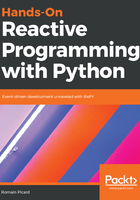
What this book covers
Chapter 1, An Introduction to Reactive Programming, gives an overview of event-driven programming and reactive programming.
Chapter 2, Asynchronous Programming in Python, presents the foundations of asynchronous programming and the different ways to deal with input/output. It provides an initial introduction to AsyncIO.
Chapter 3, Functional Programming with ReactiveX, provides insights on how to structure the code of an application with ReactiveX, and how to use functional programming in particular.
Chapter 4, Exploring Observables and Observers, goes into the details of observables and observers, and all the possible ways to create observables.
Chapter 5, Concurrency and Parallelism in RxPY, explains how RxPY manages CPU concurrency via schedulers.
Chapter 6, Implementation of an Audio Transcoding Server, goes through the initial implementation of a realistic reactive and functional application.
Chapter 7, Using Third-Party Services, is a continuation of the previous chapter, explaining how to integrate an existing SDK with AsyncIO and RxPY. It also introduces Docker, a container-management platform.
Chapter 8, Dynamic Reconfiguration and Error Management, goes into functionalities and robustness in more depth, explaining how ReactiveX makes it simple to manage dynamic changes.
Chapter 9, Operators in RxPY, runs through a detailed documentation of 40 widely used operators that have not been covered in the book so far.
Chapter 10, Testing and Debugging, explains how to test reactive code, and how to debug it.
Chapter 11, Deploying and Scaling Your Application, shows how to deploy a Python application on the cloud and how to scale it, thanks to Docker, Docker Compose, and Traefik.
Chapter 12, Reactive Streams for Remote Communication, covers a rather advanced topic. It paves the way to reactive systems, and the global use of observables to communicate between applications.
Chapter 13, A Checklist On Best Practices, contains some final notes on things that are easy to forget when starting to code reactive applications.